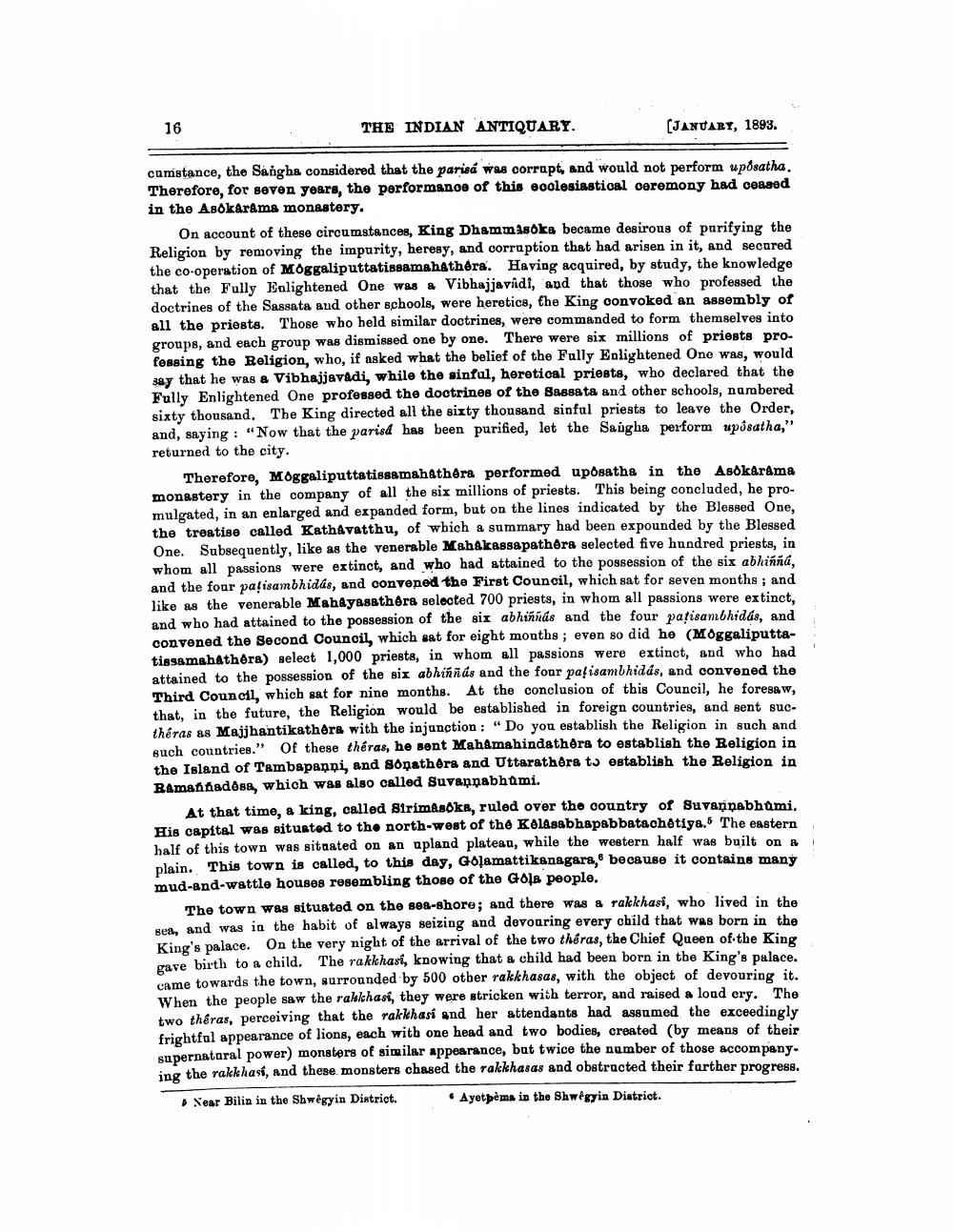________________
16
THE INDIAN ANTIQUARY.
(JANUARY, 1893.
cumstance, the Sangha considered that the parisá was corrupt, and would not perform uposatha. Therefore, for seven years, the performanoe of this ecclesiastical ceremony had ceased in the Asokar&ma monastery.
On account of these circumstances, King Dhammasoka became desirous of purifying the Religion by removing the impurity, heresy, and corruption that had arisen in it, and secured the co-operation of MoggaliputtatissamahAthéra. Having acquired, by study, the knowledge that the Fully Enlightened One was a Vibhajjavadi, and that those who professed the doctrines of the Sassata and other schools, were heretics, the King convoked an assembly of all the priests. Those who held similar doctrines, were commanded to form themselves into groups, and each group was dismissed one by one. There were six millions of priests professing the Religion, who, if asked what the belief of the Fully Enlightened One was, would say that he was a Vibhajjavadi, while the sinful, heretical priests, who declared that the Fully Enlightened One professed the doctrines of the Sassata and other schools, numbered sixty thousand. The King directed all the sixty thousand sinful priests to leave the Order, and, saying: "Now that the parisd has been purified, let the Sangha perform uposatha," returned to the city.
Therefore, Moggaliputtatissamahathêra performed uposatha in the Asokarama monastery in the company of all the six millions of priests. This being concluded, he promulgated, in an enlarged and expanded form, but on the lines indicated by the Blessed One, the treatise called KathAvatthu, of which a summary had been expounded by the Blessed One. Subsequently, like as the venerable Mahakassapathêra selected five hundred priests, in whom all passions were extinct, and who had attained to the possession of the six abhiññá, and the four paļisambhidás, and convened the First Council, which sat for seven months; and like as the venerable Mah&yasathêra selected 700 priests, in whom all passions were extinct, and who had attained to the possession of the six abhiññás and the four pațisambhidás, and convened the Second Council, which sat for eight months ; even so did he (MoggaliputtatissamahAthéra) select 1,000 priests, in whom all passions were extinct, and who had attained to the possession of the six abhiññás and the four pafisambhidds, and convened the Third Council, which sat for nine months. At the conclusion of this Council, he foresaw, that, in the future, the Religion would be established in foreign countries, and sent suc. théras as Majjhantikathëra with the injunction : "Do you establish the Religion in such and such countries." Of these théras, he sent Mahamahindathers to establish the Religion in the Island of Tambapanni, and soņathöra and Uttarathera to establish the Religion in Ramanadose, which was also called Suvaņpabhami.
At that time, a king, called Sirim soke, ruled over the country of Suvarnabhumi, His capital was situated to the north-west of the Kolasabhapabbatachétiya. The eastern half of this town was situated on an apland plateau, while the western half was built on a plain. This town is called, to this day, Goļamattikanagara, because it contains many mud-and-wattle houses resembling those of the Gola people.
The town was situated on the sea-shore; and there was a rakkhasi, who lived in the Bea, and was in the habit of always seizing and devouring every child that was born in the King's palace. On the very night of the arrival of the two théras, the Chief Queen of the King gave birth to a child. The rakkhasí, knowing that a child had been born in the King's palace. came towards the town, surrounded by 500 other rakkhasas, with the object of devouring it. When the people saw the rakichasi, they were stricken with terror, and raised a loud cry. The two thêras, perceiving that the rakkhasi and her attendants had assumed the exceedingly frightful appearance of lions, each with one head and two bodies, created by means of their supernatural power) monsters of similar appearance, but twice the number of those accompany. ing the rakkhasí, and these monsters chased the rakkhasas and obstructed their further progress.
Near Bilin in the Shwegyin District. Ayetpèma in the Shwégyin District.




